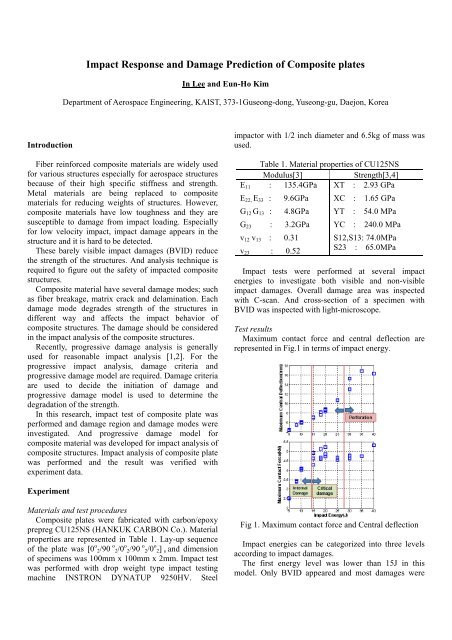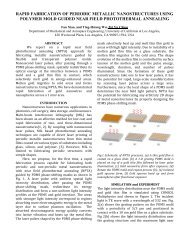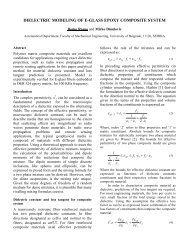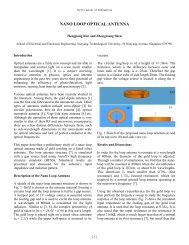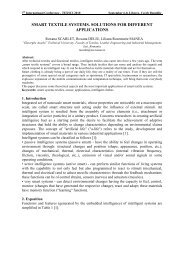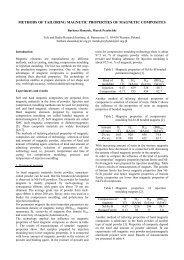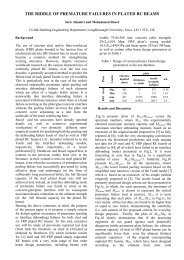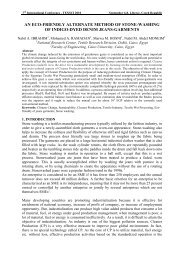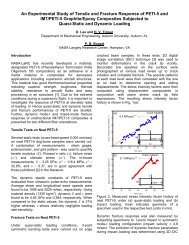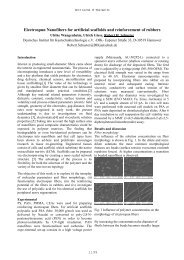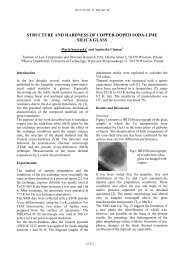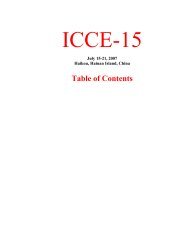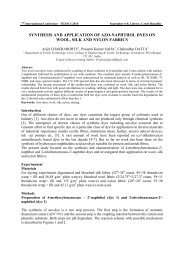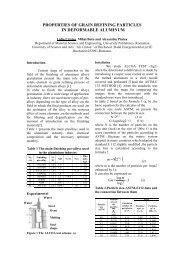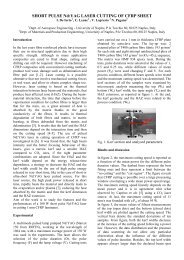Impact Response and Damage Prediction of Composite plates
Impact Response and Damage Prediction of Composite plates
Impact Response and Damage Prediction of Composite plates
You also want an ePaper? Increase the reach of your titles
YUMPU automatically turns print PDFs into web optimized ePapers that Google loves.
<strong>Impact</strong> <strong>Response</strong> <strong>and</strong> <strong>Damage</strong> <strong>Prediction</strong> <strong>of</strong> <strong>Composite</strong> <strong>plates</strong><br />
In Lee <strong>and</strong> Eun-Ho Kim<br />
Department <strong>of</strong> Aerospace Engineering, KAIST, 373-1Guseong-dong, Yuseong-gu, Daejon, Korea<br />
Introduction<br />
Fiber reinforced composite materials are widely used<br />
for various structures especially for aerospace structures<br />
because <strong>of</strong> their high specific stiffness <strong>and</strong> strength.<br />
Metal materials are being replaced to composite<br />
materials for reducing weights <strong>of</strong> structures. However,<br />
composite materials have low toughness <strong>and</strong> they are<br />
susceptible to damage from impact loading. Especially<br />
for low velocity impact, impact damage appears in the<br />
structure <strong>and</strong> it is hard to be detected.<br />
These barely visible impact damages (BVID) reduce<br />
the strength <strong>of</strong> the structures. And analysis technique is<br />
required to figure out the safety <strong>of</strong> impacted composite<br />
structures.<br />
<strong>Composite</strong> material have several damage modes; such<br />
as fiber breakage, matrix crack <strong>and</strong> delamination. Each<br />
damage mode degrades strength <strong>of</strong> the structures in<br />
different way <strong>and</strong> affects the impact behavior <strong>of</strong><br />
composite structures. The damage should be considered<br />
in the impact analysis <strong>of</strong> the composite structures.<br />
Recently, progressive damage analysis is generally<br />
used for reasonable impact analysis [1,2]. For the<br />
progressive impact analysis, damage criteria <strong>and</strong><br />
progressive damage model are required. <strong>Damage</strong> criteria<br />
are used to decide the initiation <strong>of</strong> damage <strong>and</strong><br />
progressive damage model is used to determine the<br />
degradation <strong>of</strong> the strength.<br />
In this research, impact test <strong>of</strong> composite plate was<br />
performed <strong>and</strong> damage region <strong>and</strong> damage modes were<br />
investigated. And progressive damage model for<br />
composite material was developed for impact analysis <strong>of</strong><br />
composite structures. <strong>Impact</strong> analysis <strong>of</strong> composite plate<br />
was performed <strong>and</strong> the result was verified with<br />
experiment data.<br />
impactor with 1/2 inch diameter <strong>and</strong> 6.5kg <strong>of</strong> mass was<br />
used.<br />
Table 1. Material properties <strong>of</strong> CU125NS<br />
Modulus[3]<br />
Strength[3,4]<br />
E 11 : 135.4GPa XT : 2.93 GPa<br />
E 22, E 33 : 9.6GPa XC : 1.65 GPa<br />
G 12 G 13 : 4.8GPa YT : 54.0 MPa<br />
G 23 : 3.2GPa YC : 240.0 MPa<br />
v 12 v 13 : 0.31 S12,S13: 74.0MPa<br />
v 23 : 0.52<br />
S23 : 65.0MPa<br />
<strong>Impact</strong> tests were performed at several impact<br />
energies to investigate both visible <strong>and</strong> non-visible<br />
impact damages. Overall damage area was inspected<br />
with C-scan. And cross-section <strong>of</strong> a specimen with<br />
BVID was inspected with light-microscope.<br />
Test results<br />
Maximum contact force <strong>and</strong> central deflection are<br />
represented in Fig.1 in terms <strong>of</strong> impact energy.<br />
Experiment<br />
Materials <strong>and</strong> test procedures<br />
<strong>Composite</strong> <strong>plates</strong> were fabricated with carbon/epoxy<br />
prepreg CU125NS (HANKUK CARBON Co.). Material<br />
properties are represented in Table 1. Lay-up sequence<br />
<strong>of</strong> the plate was [0 o 2/90 o 2/0 o 2/90 o 2/0 o 2] s <strong>and</strong> dimension<br />
<strong>of</strong> specimens was 100mm x 100mm x 2mm. <strong>Impact</strong> test<br />
was performed with drop weight type impact testing<br />
machine INSTRON DYNATUP 9250HV. Steel<br />
Fig 1. Maximum contact force <strong>and</strong> Central deflection<br />
<strong>Impact</strong> energies can be categorized into three levels<br />
according to impact damages.<br />
The first energy level was lower than 15J in this<br />
model. Only BVID appeared <strong>and</strong> most damages were
matrix crack <strong>and</strong> delamination. Fiber damage did not<br />
appear. Second energy level was between 15J <strong>and</strong> 30J,<br />
the <strong>plates</strong> were critically damaged with fiber breakage.<br />
Contact force was suddenly decreased with critical<br />
damage <strong>and</strong> the damages clearly appeared in the impact<br />
surface. Third energy level was larger than 30J.<br />
<strong>Composite</strong> <strong>plates</strong> were perforated by the impactor <strong>and</strong><br />
central deflections abruptly increased <strong>and</strong> were not<br />
recovered. The largest damage mode was delamination<br />
for all case.<br />
<strong>Damage</strong> area at 5J was compared with C-scan image<br />
in Fig. 3. Overall impact damages are shown in C-scan<br />
image around the impact location. <strong>Damage</strong> area<br />
obtained from numerical analysis was overlapped on the<br />
C-scan image. The largest damage area was<br />
delamination <strong>and</strong> the damage area is comparable to C-<br />
scan image.<br />
Analysis<br />
<strong>Impact</strong> analysis was performed with finite element<br />
program ABAQUS/explicit. Progressive damage<br />
analysis was used for reasonable impact analysis.<br />
<strong>Damage</strong> analysis algorithm was developed based on<br />
maximum failure strain criteria <strong>and</strong> continuum damage<br />
mechanics[5]. It was assumed that the progression <strong>of</strong><br />
matrix <strong>and</strong> fiber damage is following the cumulative<br />
Weibull distribution as shown in Eq. (1).<br />
0<br />
m<br />
⎧⎪<br />
1 ⎛E<br />
ε ⎞ ⎫⎪<br />
d = 1−exp⎨−<br />
⎜ ⎟ ⎬<br />
⎪ me ⎝ X<br />
⎩ ⎠ ⎪⎭<br />
(1)<br />
where, m is a shape parameter <strong>and</strong> X, E 0 ,ε are strength,<br />
initial stiffness, <strong>and</strong> strain, respectively.<br />
The algorithm was implemented in ABAQUS/explicit<br />
user defined material subroutine, VUMAT. Cohesive<br />
elements were used to simulate delamination failure.<br />
Quad model was used to reduce the computation<br />
times.<br />
Results <strong>and</strong> Discussion<br />
Contact forces <strong>of</strong> 5J <strong>and</strong> 15J are compared with<br />
experiment data in Fig. 2. At 5J <strong>of</strong> impact energy only<br />
BVID appears. At 15J <strong>of</strong> impact energy composite plate<br />
critically damaged <strong>and</strong> contact forces abruptly decreased.<br />
Analyses well estimate the critical damage.<br />
Fig 2. Contact force history<br />
Fig 3. Comparison <strong>of</strong> damage area at 5J<br />
The developed damage model algorithm well<br />
estimates the impact damages both <strong>of</strong> BVID <strong>and</strong> critical<br />
impact damage.<br />
Acknowledgement<br />
This research was supported by the second stage <strong>of</strong><br />
the Brain Korea 21 Project in KAIST <strong>and</strong> WCU(World<br />
Class University) program through the National<br />
Research Foundation <strong>of</strong> Korea funded by the Ministry <strong>of</strong><br />
Education, Science <strong>and</strong> Technology(R31-2008-000-<br />
10045-0).<br />
References<br />
1. Donadon, M.V., Iannucci, L., Falzon, B.G.,<br />
Hodgkinson, J.M., Almeida, S.F.M., A progressive<br />
failure model for composite laminates subjected to<br />
low velocity impact damage, Compu. And Struct.,<br />
86(2008), 1232-1252.<br />
2. Chang, K.-Y, Liu, S., Chang, F.-K., <strong>Damage</strong><br />
tolerance <strong>of</strong> laminated composites containing an<br />
open hole <strong>and</strong> subjected to tensile laodings, J.<br />
compo. Mater., 25(1991), 274-301.<br />
3. Choi, I.H., Hong, C.S., New approach for simple<br />
prediction <strong>of</strong> impact force history on composite<br />
laminates, AIAA journal, 32(1994), 2067-2072.<br />
4. Kang, S.-G., “Characteristics <strong>of</strong> composite materials<br />
<strong>and</strong> application to the cryogenic propellant tank”,<br />
Doctoral dissertation KAIST(2006).<br />
5. Matzenmiller, A., Lubliner, J., Taylor, R.L., A<br />
constitutive model for anisotropic damage in fibercomposites,<br />
Mech. Mater., 20(1995), 125-152.


